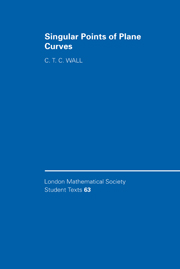Book contents
- Frontmatter
- Contents
- Preface
- 1 Preliminaries
- 2 Puiseux' Theorem
- 3 Resolutions
- 4 Contact of two branches
- 5 Topology of the singularity link
- 6 The Milnor fibration
- 7 Projective curves and their duals
- 8 Combinatorics on a resolution tree
- 9 Decomposition of the link complement and the Milnor fibre
- 10 The monodromy and the Seifert form
- 11 Ideals and clusters
- References
- Index
8 - Combinatorics on a resolution tree
Published online by Cambridge University Press: 04 December 2009
- Frontmatter
- Contents
- Preface
- 1 Preliminaries
- 2 Puiseux' Theorem
- 3 Resolutions
- 4 Contact of two branches
- 5 Topology of the singularity link
- 6 The Milnor fibration
- 7 Projective curves and their duals
- 8 Combinatorics on a resolution tree
- 9 Decomposition of the link complement and the Milnor fibre
- 10 The monodromy and the Seifert form
- 11 Ideals and clusters
- References
- Index
Summary
Although invariants for a curve with a single branch can be written in sequence, and calculated in terms of the Puiseux characteristic, for curves with several branches it is necessary to work on a tree. In this chapter we consider the dual graph of a tree produced from a plane by an arbitrary sequence of point blowings up. We will see that many invariants can be most conveniently expressed using the algebra of exceptional cycles on the surface T which is the result of the blowings up. This leads to many formulae; some of these complete the development of Chapter 4, others lead to a study of the ‘topological zeta function’.
We also prepare for the discussion of the topology of the Milnor fibration in Chapters 9 and 10. Indeed, on the boundary we have an isomorphism ∂T → ∂S, so ∂T includes the singularity link complement and allows a fairly explicit description of it, and of the Milnor fibration, which we will give in Chapter 9. Here we will introduce the invariants and notation in terms of which the later calculations will be expressed.
The homology of a blow-up
Let C be a curve defined near O ∈ 2, with branches Bj. We recall that by Theorem 3.4.4, C has a good resolution, which is a map π : T → S, where S is a (small enough) disc neighbourhood of the point O ∈ 2. The map π gives an isomorphism (T − π−1(O)) → (S − O), and the collection π−1(C) of curves has normal crossings. Moreover, π is constructed as a composite of maps πi : Ti+1 → Ti (with T0 = S), each obtained by blowing up a single point Oi, which thus gives rise to an exceptional curve Ei ⊂ Ti+1.
- Type
- Chapter
- Information
- Singular Points of Plane Curves , pp. 187 - 218Publisher: Cambridge University PressPrint publication year: 2004



